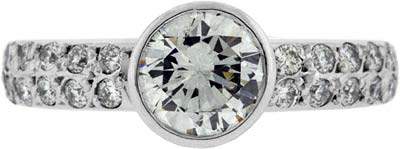| The Very Highest Quality Jewellery Information... |
| Cleaning Jewellery |

|
Gold Jewellery
Most gold jewellery can be cleaned in warm soapy water, and can be gently brushed if necessary using an old tooth brush.
Gold Alloys
High carat alloys such as 18 carat and above, will not usually become tarnished, and will not be harmed by household chemicals.
Lower carat gold can be harmed by contact with chlorine based bleach and cleaning chemicals.
Chlorine can cause stress corrosion cracking in lower gold alloys of 14 carat and below, although it will be worse if the jewellery contains porosity through less than perfect manufacturing treatments. Because of this it is best to avoid cleaning your jewellery with bleach or other cleaners containing chlorine, and also to avoid wearing it when in contact with bleach.
Diamonds
Diamonds are almost impossible to damage, the only precaution which should be observed is to avoid two diamonds rubbing together during cleaning, as they can scratch and cause abrasion to each other.
Reasonable care should be taken not to catch diamond settings with filaments of thread, particularly strong synthetic threads which may bend claws, and loosen the stones they are meant to be securing.
To remove caked-on grease and other dirt from the backs of stones, we recommend an old toothbrush and warm soapy water.
Other Gemstones
Ruby and sapphire are easy to clean in the same way as diamonds, and they require no special care. Again it is sensible to ensure that stones cannot rub against other stones during cleaning.
Other stones may need special care, it is best to read our notes about the specific stones. See our A to Z of Gemstones.
Proprietary Jewellery Cleaner
Most jewellers now sell tubs of "Jewellery Cleaner". Although it will clean your jewellery, it will not necessarily work any better than the warm soapy water we recommend above.
Ultrasonic Cleaners
Jewellery manufacturers and workshops use ultrasonic cleaning tanks. In these, the actual cleaning is performed by the cleaning solution, usually a mixture of ammonia and detergent, the ultrasonics merely provide the agitation to speed up the process.
Small domestic ultrasonic cleaners are now available, and many jewellery stores sell them as gift items. We are not convinced that they work better than soap and water.
Tarnish
Low carat gold alloys will tarnish or discolour through exposure to air. This tarnish is not removed by ordinary cleaning. To remove it will usually require the application of gentle abrasive to rub away the layer of tarnished gold. In jewellery workshops, acid may to used to dissolve the tarnish layer, but this is not practical at home.
The best way to avoid tarnish is to buy 18 carat gold jewellery, which hardly ever becomes tarnished.
Silver
Silver tarnishes easily, but the tarnish is easily removed using proprietary silver cleaning solutions, such as Goddard's Silver Dip.
Platinum
Clean platinum as for high carat golds. Platinum, like high carat gold alloys is highly resistant to tarnishing.
Repolishing
If jewellery with polished surfaces becomes matt and dull over long periods of wear, it can usually be repolished, but we believe that this is not really necessary. Items like wedding rings are bound to become scratched, but we believe that, particularly with high carat golds and platinum, the intrinsic colour of the metal retains its beauty even when scratched and worn.
Gemstone Settings
It is advisable to avoid cleaning stone-set jewellery in a hand-basin or sink. If stones become loose in cleaning, they can easily become lost down the drain.
Right after cleaning is a very common time to discover that stones are missing. Occasionally careless cleaning can be the cause, but usually wear and tear over a period of time are the real cause, and the cleaning merely appears to be the cause. Damage and trauma to jewellery can occur in everyday use, and sometimes the stones are only held in their settings by a build up of grease. When this is removed by cleaning, the stones drop out.
Literally, dirt and grease were the only things holding the stones in place!
Jewellers Get the Blame!
We believe that jewellers are frequently blamed wrongly for dislodging stones when jewellery items are repaired. Often, it will be the first time the jewellery has been cleaned since it was purchased, and it may need cleaning before it can be thoroughly examined to determine what work is needed. It will be further cleaned, sometimes several times during repair work.
Even non-intrusive work, such as appraisal for valuation, usually require that the jewellery be cleaned first. Most weeks, we get customers who expect valuation work to be carried out while they wait, not realising that it may take half a day just to remove ten years build up of debris.
See our Gemstones A to Z page for information about different individual gemstones and cleaning them.
| ...at the Lowest Possible Price |
|
32 - 36 Harrowside, Blackpool, Lancashire, FY4 1RJ, England. Telephone (44) - (0) 1253 - 343081 ; Fax 408058; E-mail: The URL for our main page is: https://24carat.co.uk | Chard(1964) Ltd |